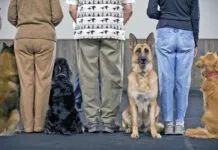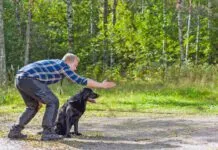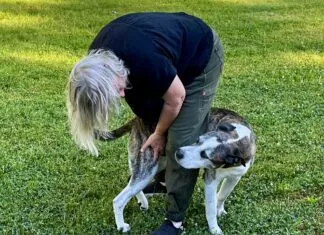Smedly is one lucky dog. He gets a minimum of a half-hour of hard exercise every day. On many days, he gets a lot more. Long hikes in the woods, runs on the beach, swimming, and chasing tennis balls are all part of his regular routine. In addition, Smedly trains for agility a couple of times a week. For some of us, this may seem like a lot of exercise. But for a healthy, fit, two-year-old Border Collie mix like Smedly, a high level of exercise is a necessity.
“If he doesn’t get enough exercise, he doesn’t relax at home,” says Betsy Jones, who shares her life with Smedly. From the day she brought him home from the shelter as a six-week-old puppy, he’s needed a lot of exercise. And, if he doesn’t get it, they both suffer. “He becomes hyper-vigilant about every sound and movement outside the window. He bothers the cat, too.”
In fact, when dogs don’t get enough exercise, they are much more likely to bark at the neighbors, chew on things they shouldn’t, dig holes in the garden and generally get into trouble. Dogs who are in good shape and getting plenty of exercise tend to act out less. You’ve probably seen it with your dog. Simply giving your dog enough exercise can dramatically reduce problem behaviors and make life a whole lot more enjoyable.

But the behavioral benefits of exercise are only the beginning. Regular exercise can also help your dog live a healthier life. Just like with people, walking, running, swimming and other physical activities can strengthen a dog’s heart and lungs and help ward off serious diseases. Regular exercise strengthens bones and muscles, too. Because stronger muscles can help stabilize joints, exercise may even slow the progression of degenerative joint diseases such as hip dysplasia and arthritis.
Plus, exercise can keep your dog from putting on extra pounds – or help them take it off if they are already on the chubby side. “Being lean is the key to good health in dogs,” says Dr. Kerrin Hoban, a veterinarian who practices in Santa Cruz, California. “And being fit can help dogs stay lean.”
How much is enough?
Not every dog will need the kind of exercise that Jones gives Smedly. Some dogs will need less – some only need a little. Part of your job as your dog’s caretaker and coach is to determine how much is just right.
Size and body type play an important part in how much exercise is right. Small, short-legged dogs may be able to get by on a half-mile walk a day whereas a medium-sized, long legged dog might enjoy several-mile runs each day.
“Mooch, who is a cross between Benji and Toto, weighs 17 pounds and has 4-inch legs. She only needs about a half hour walk a day,” says Cynthia Landis, who lives in Los Angeles, California with her two mixed breed dogs. She compares Mooch’s needs to her young dog Rudy, a seven-month-old Retriever-Shepherd mix. “Ideally, Rudy needs at least an hour walk plus a couple of ball sessions every day.”
Age can also affect your dog’s needs for activity. Puppies younger than six months need only moderate exercise; people need to take care to avoid over-exercising pups. Until a dog is about two years old, it’s also a good idea to avoid very strenuous, repetitive, or jarring exercises that may impact their bone and joint development. Older dogs (it depends on the breed or mix, but dogs over seven years of age are generally considered “older”) may also have special needs. Older dogs generally thrive on regular exercise, but you may need to decrease the amount or intensity.
Just as important as size, body type and age, is the lifestyle we expect our dogs to live. For some, having your dog in shape will simply mean the bare minimum to keep him or her in good health. You may be able to help your dog achieve physical fitness goals through daily walks or other casual activities. Others may enjoy sharing more strenuous activities such as hiking or biking. Still others may train for competitive sports such as agility or Frisbee or have working dogs whose jobs may require extreme fitness (search and rescue dogs, for example). Your dog’s workout routine may need to be specifically designed to support your and your dog’s lifestyle as well as his overall health.
A word of caution: If you expect your dog to share strenuous activities such as grueling hikes or agility, daily exercise becomes even more important. Avoid the weekend warrior syndrome. Dogs (and people too!) who engage in sports or other strenuous activities sporadically are at a much greater risk for serious injuries than those who workout regularly.
Talk to your vet
It is always a good idea to check with your veterinarian before you start a conditioning or exercise program. Ask your veterinarian to assess your dog’s heart, respiratory system, muscular and skeletal condition, and general health. This is an especially good idea if your dog is overweight or has medical conditions that may affect exercise needs.
Overweight dogs, for example, are at higher risk of orthopedic problems and shouldn’t do too much running that involves quick turns until they have slimmed down. Your veterinarian can help you decide how much weight your dog needs to lose and how to best lose that weight, including suggestions for changing your dog’s diet and exercise.
“I have people start with walking until the dog is at a normal weight,” says Dr. Hoban. “Once the dog is at a normal weight, then you can increase the exercise.”
You may also want to ask your veterinarian for suggestions on diet if your dog is engaging in a more strenuous conditioning program. Dogs who are training for endurance sports like sled racing or long backpacking excursions may need to eat a higher-energy or higher-fat diet.
If your dog has joint problems or arthritis, your veterinarian can give you advice on how much and what type of exercise will be best. For most dogs with arthritis, for example, regular exercise of moderate intensity is recommended. But, you should stop the exercise at the first sign of fatigue (slowing down, panting, toe scuffing) to avoid aggravating the condition.
Choose activities you enjoy
Many of us have tried the old drudgery exercise routine in our lives. You know, signing up at a gym, going for the first week, then never going again. How can you make it different now for you and your dog?
There is little doubt that most of our dogs love some type of exercise – walking, running, chasing balls or romping with other dogs. The secret is making it fun for you both. The more fun you have, the more likely you are to stick with it. Doing a variety of different activities will make it all the more fun for you and your dog. Plus, by doing a variety of activities, you’ll have the added benefit of canine cross training!
Warm up, cool down, have fun
Just what activities are good for turning your couch puppy into a canine athlete? The following are just a few suggestions to get you started. But before going all-out with any of the exercises described below – or any other strenuous activity – help your dog warm up and cool down. Just like with people, warming up the muscles will help prevent injury. You can have your dog warm up as a natural part of the activity. For example, take it slowly on the first 5 to 10 minutes of your walk or jog, and go slowly again at the end for a cool down.
You may also want to have your dog do specific movements after he or she is warmed up to stretch the muscles. Play bows and figure eight weaves between your legs are good ways to get your dog to gently stretch and twist. And, after a hard workout, a massage can help your dog loosen up and ease sore muscles. (See “Pre- and Post-Sports Massage,” WDJ August 2000 for more information on canine massage.)
Walking and Hiking
This is the all-time favorite pastime for most of us with dogs. It’s easy, cheap and requires only a good pair of shoes, a leash and a pooper-scooper or plastic bags. You can take neighborhood walks or head for local hiking trails. When you walk for exercise, keep up a good pace, slowly increase the length of the walks and head for increasingly hilly terrain. Have fun exploring new places.
Jogging
Dogs make great jogging companions and jogging is a quick and efficient exercise. It’s a good way for both you and your dog to get a good workout – especially if you have limited time. Be careful, however, not to jog long distances with your dog on sidewalks and streets. Choose to run through parks or other areas with more forgiving surfaces such as dirt or grass. Running on hard surfaces makes dogs more susceptible to strain on their joints and bones; remember, they don’t have the added protection offered by a pair of good running shoes.
Swimming
Swimming is great exercise for dogs. It is especially good for dogs with joint problems or arthritis because swimming builds endurance and strength without stressing joints. If you have access to a pool, lake, or pond that is safe for swimming, and if your dog likes water, you’re set. Retrieving a ball or bumper will make it all the more fun.
Make sure the water is flat or slow moving, is free of underwater hidden obstacles, and is warm enough for safe swimming (if the water is cold enough that it would be unthinkable for you to swim in the water, it’s probably too cold for your dog to swim, too). Please note: Dogs can easily overdo swimming. Use caution and know your dog’s limits. (See “In the Swim,” WDJ August 2000, for tips on safe swimming and information on positive swim training.)
Retrieving
Does your dog like to play retrieving games? Tossing a tennis ball or Frisbee for your dog can keep him running with little effort on your part. It’s a great exercise for busy days when you don’t have quite enough time for a long outing or if you have physical limitations that make it hard to take long walks. For a variation that gets your dog running but saves your arm, use a tennis or racquetball racket to hit the ball. Keeping the ball or Frisbee low will help reduce the risks associated with jumping high in the air or twisting for the catch.
Agility, Flyball and Flygility
These are just a few of the many dog sports you and your dog can play for fun and exercise. Agility is a sport where you direct your dog through a timed obstacle course of jumps, tunnels, and climbing structures. In flyball, a team of four dogs runs a relay race. Each dog goes over a series of hurdles, steps on a spring-loaded box, catches the ball that is shot from the box, and then runs back over the hurdles. Flygility is a newer sport that combines elements of both agility and flyball. The great advantage of sports like agility or flyball is that they combine exercise, training and play all into one. These sports can be played for fun or competition and are a great way for you to get to know other dogs and their people.
Canine Musical Freestyle
If canine sports don’t strike your fancy, how about dancing with your dog? Musical Freestyle is both great exercise and great fun. People and dogs work out a choreographed dance routine that includes elements of obedience and trick training. Music, dogs, dance. What more could you want?
Hide and Seek and Other Indoor Games
Don’t let bad weather cancel your dog’s exercise! Teaching your dog to search for hidden objects is a great game that can be played indoors or wet or snowy days. The basic idea is to hide your dog’s favorite toy and have him find it. When your dog is first learning the game, you can hide it with your dog watching. Then, slowly increase the difficulty until you hide it in another room and send your dog to find it.
For dogs that aren’t into toys, you can hide a bone or stuffed Kong. Or, try hiding yourself. Leave your dog on a stay in one room and hide in another. Then call, “Come find me.” The more excited you are when your dog finds you, the better he or she will like the game.
Uncountable benefits
Exercising is good for your dog. Dogs who exercise are better behaved, easier to live with and overall healthier. Plus, providing your dog with opportunities to exercise is a great way to spend time together.
“Hiking in the woods on rugged trails swimming in the lake, chasing sticks on the beach – with dogs, it’s all about playing,” says Jones about her time exercising with Smedly. “We can really learn a lot from our dogs. They make play out of their work. Smedly reminds me to play and gives me a partner in play. And playing together makes us better friends.”
-By Mardi Richmond







